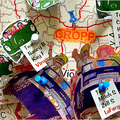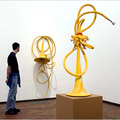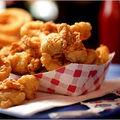PULA, Croatia
THE spring obsession in Istria is wild asparagus. Throughout the peninsula, which juts into the Adriatic across from Venice — just a ferry ride away — people are walking through open fields and along roadsides, carrying the stout sticks they use to shove aside the brambles that hide the precious, knitting-needle-thin stalks.
For many in this section of Croatia, any free nutrition is good nutrition. And for those who are better off it’s simply a matter of getting the best food, directly from the land.
On the early spring days, I see neighbors talking as they burn the wooden detritus of winter, harvest the cabbage and kale that made it through the winter, and ready their gardens (almost everyone has one).
As in much of Central Europe, Istria’s bloodlines are complicated. The Romans built Pula, at Istria’s southern tip, as an important port; the Venetians ruled it for centuries and the Austrians treasured it as a major outlet to the sea. Under Marshal Tito’s regime, those of Italian origin — a large, once-powerful minority — were violently “encouraged“ to leave what was then Yugoslavia. Now, Istrians are trying not to be overrun by the Italians, Austrians and Germans who see it as a summer playground.
That the region’s identity is torn between its past and its present is readily apparent. Everyone is at least bilingual, and everything has at least two names. A typical type of pasta is called fusi istriani in Italian, fuzi istrijani if you’re speaking in mixed company, or istarki fuzi in Croatian.
In some towns — the lovely Rovinj, for example (or Rovigno, if you prefer) — the shopkeepers initially greet you with “buon giorno”; in others it’s “dobro jutro.” And many conversations take place in two languages, mightily confusing those of us who think we speak a bit of Italian.
The cuisine, however, is at least as “Italian” as it is in Venice or Palermo, which is to say that there is pasta, there is olive oil, there is rosemary (there is sauerkraut, too, but there’s sauerkraut all over northern Italy), and there is that certain sensibility of straightforwardness and seasonality, all of which put together has become almost universally popular and recognizable.
One of its most ardent boosters is Lidia Bastianich, the Istrian-born chef, author, television personality and New Yorker (she moved there when she was 12, just after the mass relocation of ethnic Italians, and grew up in Queens). In fact, Ms. Bastianich boldly opens “Lidia’s Italy” (Knopf), her latest book, with a chapter on Istria, which is decidedly not Italy, at least politically. (The book was written with her daughter, Tanya Bastianich Manuali; the accompanying public television series, “Lidia’s Italy,” began last month.)
It’s difficult to remember this, though, when you’re here. On a sunny, unseasonably warm day about a month ago, just outside of Pula, Lidia and I were foraging for asparagus in order to make a frittata. We found six spears in an hour. It was early in the season (though it’s worth noting that even the best fishermen catch nothing in my presence), but the local market had — literally — a bunch, so our next morning’s breakfast was secure.
That same day, we settled in for a leisurely afternoon at her family home in Busoler, just outside of Pula. One cousin made a simple but intricately flavored pasta sauce from a just-killed rooster, some onions, a bit of tomato. In a covered pot in the coals of the room’s fireplace another cousin roasted a goat — with a couple of sprigs of rosemary, some laurel leaves and salt — that had been living 50 feet away.
The reverence for the animals who had given their lives to grace this table was palpable and unavoidable. Still, it was the most delicious goat I’ve ever tasted.
Everywhere Lidia and I traveled there was this same combination of almost absurdly simple cooking, few but absolutely local and seasonal ingredients, and a lot more labor than most Americans normally put into their food. (As a rule, we don’t forage much, we don’t cook in wood fires, we don’t hand-make pasta, and we certainly don’t kill our own animals.)
The results, in the better restaurants at least, are the same as those that some people travel to Italy for. Indeed, Italians will drive over for a single meal (you can drive from Trieste deep into Istria in little over an hour).
No wonder. Lidia and I met in Trieste, then traveled through a rugged bit of Slovenia, arriving in Istria above Opatija, a favorite of Emperor Franz Joseph. It’s a town of much faded glory and spectacular hillside views of islands and water. (The peninsula’s countryside and seaside are as beautiful as any in the Mediterranean.)
We lunched down the coast in Moscenicka Draga, visited hilltop towns that lose nothing in comparison to Tuscany, then drove over a mountain that was so rocky you could barely tell the difference between the stone walls and the ground. Along the coast to the south, past Labin, we stopped at Martin Pescator, on a bay in the town of Trget (tar-GET).
The restaurant sits on a lovely little harbor, and everything — everything — is local. There are tiny mollusks called datteri; the word is Italian for “dates,” which they resemble, a kind of combination of razor clam and mussel that burrows into rocks and takes 35 years to reach full size. (We don’t eat these, because taking them is illegal, but I’m shown them, in their rocks, before they’re put back in the bay.)
While the chef, Boris Vlacic, starts to cook his specialty — octopus and potatoes, buried in the coals of the fire — we begin eating.
First up is prosciutto, reason enough to make the trip. This is the kind of prosciutto that gave the meat its reputation, not the insipid, pale, tasteless stuff we’re often served these days, even in central Italy. It’s dark, it’s fatty, and it has just enough acidity (and perhaps rancidity) to make it sublimely compelling. With it, we eat pecorino from a nearby island called Krk; it’s dry and smacks of the herbs on which the sheep forage.
These are followed by a few raw dandoli, powerfully flavorful clams served with peppery olive oil and lemon; then some of the same steamed, along with mussoli (oyster-looking specimens that taste much like mussels) in garlic, wine and parsley. We eat a bit of pasta, of course, with shellfish.
The octopus takes a couple of hours to cook, but the process is fun to watch, and the results are splendid. To make sure we’ve had enough, the chef sends out roasted branzino and griddled sole, both perfectly done. To finish, I’m encouraged to drink grappa with honey.
To Italophiles, this all sounds oddly familiar.
The story is much the same at Restaurant Gina, outside of Pula. Before arriving there, Lidia and I walked through the Roman section of town, where she played as a child. It features one of the best-preserved coliseums in Europe. We passed a couple of the original 12 Roman gates (five remain), as well as the market, which boasts two or three bunches of asparagus.
At the restaurant, we are met by Gina Bergic herself, a 75-year-old woman with terrific energy — “Inside,” she said to me, “I’m a grand woman.” Along with her equally dynamic chef, Miriana Scremin, we made square pasta pasutice, and the classic fuzi, rolled around a stick to form a kind of elegant penne. Out her windows, there are gorgeous views of a calm inlet and the Adriatic beyond.
We eat. Her bread is biscuit-like, made with oil and a little sugar, tender but with a lightly crunchy crust, unusual and delicious. There was almost nothing to a salad of granzevole — a type of spider crab — just crab, oil, lemon and parsley. Her bobici, the local bean soup I ate three or four times in as many days, is exceptional, made with prosciutto, julienned pickled turnips and corn. (With sauerkraut added, the soup becomes yota.)
(Playing on the music system, and mildly distracting, is not the typical bad contemporary Italian music, or the occasionally heard and much better traditional Croatian music but Leonard Cohen, the Talking Heads, Depeche Mode and Lou Reed. Talk about globalization.)
A light cabbage salad is lovely, and finally we have our fuzi, with the same kind of poultry sauce Lidia’s cousin made.
My final dinner in Istria was at Agriturismo Toncic — a farm restaurant, essentially — outside the lovely little town of Zrenj, or Stridone, depending on your orientation. On warm evenings — it was not one of them — people can sit on the stone terrace, which has unobstructed views of mountains, valleys and villages. The place is open only two nights a week, because the family needs the other five days to tend the fields, forage, hunt, fish, make wine and cheese, harvest, thresh and whatever else subsistence farmers must do.
Everything we eat comes from right here, except the bottled water. The malvasia bianca, which is decent, may not be world class, but once again the prosciutto is. There’s fresh, dense cow’s cheese, again not the best but certainly good. We have a fabulous asparagus frittata, made with duck eggs; another version of bobici; polenta with hare (the highlight, along with the frittata); seared pork with potatoes and chorizo; and a good late-winter salad. Dessert was apple fritters with peach jam.
I ask to see the kitchen, which is homey. Orjeta Toncic, who owns the restaurant with her husband, Sandro, and who did the cooking, had already left for the evening, in order, her daughter said, “to cook for my dad.” He didn’t like the restaurant’s evidently too-fancy food (though what could be simpler, I don’t know).
The daughter proudly showed me some truffles, small but pungent, that they had found earlier in the week. Always the ugly American, I ask why we hadn’t been served any, and she looked at me as if I were dumb: “Because we gave you asparagus instead.”
A cuisine that has its priorities in order. Just like its former siblings across the Adriatic.






